Oahu
Articles and information about Oahu, Hawaii.
Articles and information about Oahu, Hawaii.
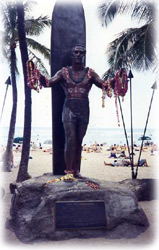 Statue of Duke Paoa Kahanamoku
Statue of Duke Paoa KahanamokuThis statue of Duke Kahanamoku honors Hawaii’s Olympic swimming champion who won three Olympic gold medals and two silver medals. Known as the father of international surfing, he was also the sheriff of Honolulu for 26 years. In 1961, Duke Kahanamoku was appointed the official city greeter and was recognized as the ambassador of Aloha the rest of his life.
The one thing I find interesting about the statue is that in the statue hw is violating one of the cardinal rules of surfing. A true surfer never turns his back to the ocean, but then I guess it’s alright here as the photo takers get a front view of Duke while capturing the ocean in their picture!
This is a very short article but I think it worth while to give you the story of this surfing legend – Duke Kahanamoku. Next, let’s look at the International Market Place.
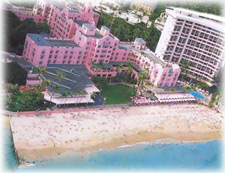 Royal Hawaiian Hotel
Royal Hawaiian HotelThe Royal Hawaiian Hotel was completed in 1927. The hotel became a part of the American war effort in early 1942 by providing rest and rehabilitation facilities for American service personnel. The great O’ahu M’ Kkuhihewa planted a sacred coconut grove about where the Royal Hawaiian Hotel and Sheraton Waikiki Hotels are today. Several descendants of these trees still stand on the mauka side of the Royal Hawaiian. The area was re-named Helumoa (chicken scratch). Legend says Kkuhihewa planted the coconut grove because the phantom rooster of Plolo, named Ka’auhelemoa, who flew down and scratched the earth at the feet of the m’. Helu means “to scratch” and moa means “chicken”.
Our quick look at the Royal Hawaiian Hotel now takes us just down Kakakaua Avenue to the statue of Duke Kahanamoku.
Kapiolani Park was dedicated on June 11, 1877, on Kamehameha Day, by King David La’amea Kalkaua and named to honor his wife, Queen Kapiolani. Many of Hawaii’s wealthy families built in the area when the park was first established. Today, the park has become a very popular gathering place for the locals. On any weekend, many families can be found using the park for outings, picnics, and barbeques.
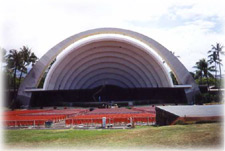 The park also serves as home for the Waikiki Shell, Waikiki Aquarium, and the Kapiolani Park Bandstand. The Waikiki Shell is used for many concerts from the Honolulu Symphonic “Pops” to Hawaiian Music. The park is also the former site of the Kodak Hula Show. At the time of printing, the show has been indefinitely stopped due to financial problems.
The park also serves as home for the Waikiki Shell, Waikiki Aquarium, and the Kapiolani Park Bandstand. The Waikiki Shell is used for many concerts from the Honolulu Symphonic “Pops” to Hawaiian Music. The park is also the former site of the Kodak Hula Show. At the time of printing, the show has been indefinitely stopped due to financial problems.
The Kapiolani Park Bandstand is used nearly daily by many groups wanting to show off their talents in presenting the many different cultures of Hawai’i.
This has been a quick overview of Kapiolani Park and what you’ll find there. Next, an article on The Royal Hawaiian Hotel.
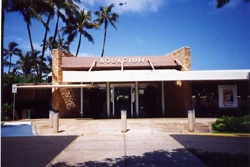 Waikiki Aquarium
Waikiki AquariumThe Waikiki Aquarium was established in March 1904 and has continuously served the Hawaiian community as well as the many visitors to Hawai’i who enjoy the exhibits. It is the third largest aquarium in the United States and at a cost of $3 million, was renovated in May 1994. The aquarium provides a “children friendly” environment with most tanks at eye level. There are over 240 species on display including the chambered nautilus, giant clam, octopus, reef fish, and Hawaii’s State Fish the numuhumu-nukunuku-a’pua’a. The main focus is on marine life of the Hawaiian Islands and the South Pacific. The aquarium also works with the University of Hawai’i on various sea life research projects. Don’t forget to visit the special tanks at the rear of the building where they are growing live coral. When the Waikiki Aquarium first opened in 1904 it was located 100 yards closer to Waikiki. Originally, there was no admission charged because they wanted to attract riders to the trolleys that serviced the Waikiki area. The cost of the trolley ride was a nickel each direction.
The Waikiki Aquarium is open daily from 9:00 am to 4:30 pm (actually closing at 5:00pm. They offer special limited hours on Thanksgiving Day and New Years Day. They are closed on Christmas Day and also the day the The Honolulu Marathon is held. The general admission is $9/adult, $4/children 13-17, $2/children 5-12, and a special discount of $6/Hawaii residents, military, students, and seniors (with ID).
Many people visit Waikiki Aquarium every week and are happy they took time from their normal “beach activities” to visit this attraction. Just across from Waikiki Aquarium you’ll find the subject of our next article, Kapiolani Park.
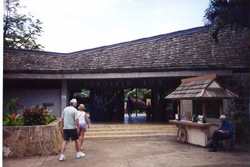 Honolulu Zoo
Honolulu ZooThe Honolulu Zoo, which is a part of Kapi’olani Park, was established in 1947 and covers 43 acres. There are over 1250 animals from 265+ species on display. There is a very relaxed atmosphere allowing you to stroll the winding pathways through gardens of flowers and tropical plants. Some of the attractions you will find are the Reptile House, Elephant Encounter, Children’s Zoo, and the newest addition, the African Savanna. In creating the 10 acre African Savanna, they have come as close as possible to duplicating the animals natural habitat.
Although rather small as zoos go, the Honolulu Zoo gets approximately 750,000 visitors peach year and has been named one of America’s best zoos. You can find the zoo at the far East end ofWaikiki at Kapahulu Avenue and Kalakaua Boulevard.
The Honolulu Zoo is open from 9:00 to 4:30 pm daily except Christmas when they are closed. There is a general admission price of $14/adult $6/child. With a local or military ID admission is $8/adult and $4/child. Children 2 and under are free.
The Honolulu Zoo is just one of the many attractions in Waikiki. Next we’ll present an article on the Waikiki Aquarium, which is just across from the Honolulu Zoo, on the ocean side of the road.
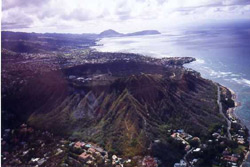 Diamond Head Crater
Diamond Head CraterDiamond Head is quite probably the most recognized landmark in Hawai’i. In ancient Hawai’i,Diamond Head was known as Lae’ahi, now shortened to Lē’ahi. Lae means “brow”, and ‘ahi is a type of fish. The name describes the shape of the crater–it looks like the brow of an ‘ahi fish. It is said that Pele’s favorite youngest sister, Hi’iaka-i-ka-poli-o-Pele, is the one who named the crater.
Later, the crater came to be known as Diamond Head. This came to be, when the first explorers arrived on O’ahu. These sailors found what they thought were diamonds, which they later learned were actually worthless calcite crystals. But, the name Diamond Head is the accepted name today.
Hawai’i’s Civil Defense headquarters, National Guard facilities, and the F.A.A. are all located in Diamond Head Crater.
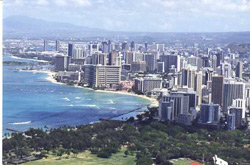 Diamond Head – Hike to the Top
Diamond Head – Hike to the TopThe public is permitted to visit the crater and to hike the trail to Diamond Head Summit. The peak is 760 feet and there are two sets of steps (99 steps and 76 steps) and a 225 foot tunnel. Don’t forget to bring lots of water! Also, a flashlight is recommended for the tunnel. The hike to the top can be done in under 45 minutes and the view is well worth it.
Admission to hike the trail is $1 and there is a $5 parking fee if you decide to drive. The city bus does stop outside the crater, but it’s quite a long walk to the entrance.
This has been our quick introduction to Diamond Head Crater. Our next article is set to be The Honolulu Zoo.
 The Beaches At Waikiki Beach
The Beaches At Waikiki BeachTechnically, there is no beach here named Waikiki. The name Waikiki Beach actually applies to a district of Honolulu which has several beaches located within the district.
Collectively the sandy area fronting Waikiki is known as Waikiki Beach, and many of the maps call the beaches Waikiki. But using the sea walls that project into the waters as a dividing line each area has different names. The meaning of the Hawaiian word Waikiki is: Wai = fresh water and kīkī = spouting. So, Waikiki means spouting fresh water. This comes from all the fresh water springs that were in the area.
Kahanamoku Beach. This beach is located fronting the Hilton Hawaiian Village. This beach was named to honor Duke Kahanamoku, two time Olympic swimming champion and Sheriff of Honolulu. The beach and lagoon area was created by Henry Kaiser and the Harbor Commission in 1955, by dredging and then filling the area with sand thus completing the addition in 1956.
Fort DeRussy Beach. Fronting Fort DeRussy and named because of the fort at Kalia. The military began proceedings to acquire the land in 1904. Much of the land was purchased from private land owners and by condemnation proceedings. The fort was originally named, Kalia Military Reservation for the ancient name of the area.
Gray’s Beach. This beach is located to the east of the Halekulani Hotel. The Hawaiian name for this beach is Kawehewehe. The early Hawaiians believed that if a person was ill, the waters of the area would cure them if they bathed in it’s water. Gray’s beach was given it’s name because of a boarding house operated by Ms La Vancha Maria Chapin in 1912. For many years this part of Waikiki beach was considered the best swimming area in the Waikiki area.
Royal Moana Beach. This beach area extends from the front of the Royal Hawaiian Hotel to the Sheraton Moana-Surfrider Hotel. The ancient name for this beach was Kahaloa named for one of the healers from Kahiki. But the modern name is more well known because of the location of the hotels bordering this beach area.
To many of the old timers this portion of the beach is still known as Taverns. In 1960, the City of Honolulu purchased the land under the tavern and demolished the building to create more beach space. The original building housing the tavern was built in 1884.
Kuhio Beach. Named after Jonah Kuhio Kalanianaole. Kuhio was a nephew to King Kalākaua and Queen Liliu’okalani and also served asHawaii’s second territorial delegate to the United States Congress.
Queens Beach. The beach was named for Queen Liliu’okalani who had a beach house in the area. This land was at one time privately owned as was much of the land fronting the shore at Kapi’olani Park. In the 1930’s, Christopher R. Holmes purchased the land and built his home on the site. He sold the home in 1946 and it was converted into a restaurant. This restaurant, “Queen’s Surf,” was very popular with visitors and locals. The restaurant was torn down in 1970 to create more open beach space by the city.
This is the beginning of our series of articles on the Island of Oahu, Hawaii. This has been Waikiki Beach and I hope you’ll have a chance to read more articles – the next will be Diamond Head Crater.
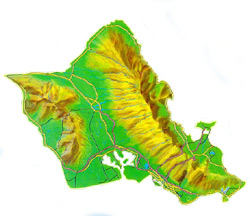 Oahu Hawaii The Gathering Place
Oahu Hawaii The Gathering PlaceOver the years, Oahu Hawaii has been where most of the activities have focused, hence the name “The Gathering Place”. With a population of over 900,000 people, Oahu Hawaii has almost 90% of the States people. Oahu Hawaii is the second oldest and third largest of the major Hawaiian Islands.
Aside from people actually first coming to Oahu Hawaii and the Hawaiian Islands, probably the first significant event was the Battle of Nuuanu which occurred in 1795. It was this battle when Chief Kamehameha won the battle for Oahu in his quest to unite what until then were the individual islands. Although not the final island in his unification quest, it was the final battle. The only remaining island was Kauai, which peaceably joined the union. It was in 1893 that the Royal family and Hawaiian Kingdom fell and in 1893 became a Territory of the United States. Hawaii remained a territory until becoming the fiftieth state in 1959.
Going back a bit, it was the 19th century that saw agriculture take off spurring the immigration of laborers from Japan, China, Korea, Puerto Rico, Portugal, Russia, and the Philippines. In the early 1900’s is when the economy started to shift from agriculture to the visitor industry. Today, tourism is by far the greatest money generator, followed by military dollars being spent, and now at a distant third is agriculture.
If you’ve spent any amount of time sitting in front of a television, you’ve almost certainly seen some of the most popular sites already. The most obvious landmark is most likely the silhouette of Diamond Head Crater as seen from Waikiki Beach. If you think of activities, you are going to be thinking of water activities and from that thought you are automatically going to have a vision of Waikiki Beach. If it’s history you are thinking of, no it’s not going to be that Battle of Nuuanu that comes to mind. It’s going to be the Battle of December 7th 1941. Yes, the “date that will live in infamy” – the Japanese attack on Pearl Harbor. With that said, a visit to Pearl Harbor, specifically the Battleship Arizona Memorial is going to be you first stop.
There are so many things to do on Oahu Hawaii that I have a set of about one hundred separate articles we are working on to be published here. Just a few of the topics for upcoming articles are, Nuuanu Pali Lookout, Iolani Palace, Kawaiahao Church, Pearl Harbor, Aloha Tower, Bishop Museum, the North Shore, Chinatown, Waikiki, and from there I’ll get into some of the many activities there are for you to enjoy.
Actually, not the final words! This isn’t even a beginning yet. Over the next days, weeks, months we will be publishing our articles on Oahu Hawaii as well as articles on the other Hawaiian Islands of Maui, Kauai, and the Big Island of Hawaii. Another nice resource for additional information is this Oahu Guide. Bookmark our site and come back often. The next in this series of articles on Oahu Hawaii is going to be a look at the beaches of Waikiki Beach.